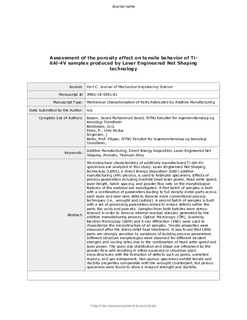| dc.contributor.author | Razavi, Seyed Mohammad Javad | |
| dc.contributor.author | Bordonaro, GG | |
| dc.contributor.author | Ferro, Paolo | |
| dc.contributor.author | Torgersen, Jan | |
| dc.contributor.author | Berto, Filippo | |
| dc.date.accessioned | 2019-02-26T14:28:30Z | |
| dc.date.available | 2019-02-26T14:28:30Z | |
| dc.date.created | 2018-11-26T14:41:35Z | |
| dc.date.issued | 2018 | |
| dc.identifier.citation | Proceedings of the Institution of mechanical engineers. Part C, journal of mechanical engineering science. 2018, . | nb_NO |
| dc.identifier.issn | 0954-4062 | |
| dc.identifier.uri | http://hdl.handle.net/11250/2587596 | |
| dc.description.abstract | Microstructural characteristics of additively manufactured Ti-6Al-4V specimens are analyzed in this study. Laser Engineered Net Shaping technology, a direct energy deposition additive manufacturing process, is used to fabricate specimens. Effects of process parameters including machine head laser power, head write speed, layer height, hatch spacing, and powder flow rate on the morphological features of the material are investigated. A first batch of samples is built with a combination of parameters leading to full density metal parts across each layer and near-zero defects likewise more conventional process techniques (i.e. wrought and casting). A second batch of samples is built with a set of processing parameters aimed to induce defects within the parts like voids and porosity. Samples from both batches were stress-relieved in order to remove internal residual stresses generated by the additive manufacturing process. Optical microscopy, scanning electron microscopy and X-ray diffraction were used to characterize the microstructure of all samples. Tensile properties were measured after the stress-relief heat treatment. It was found that Laser Engineered Net Shaping technology parts are strongly sensitive to variations of building process parameters. Different structure morphologies were observed for different incident energies and cooling rates due to the combination of laser power and head write speed. The grain size distribution and shape are influenced by the powder flow rate resulting in either equiaxed or columnar grain microstructures with the development of material defects such as pores, gas entrapment and lack of fusion. Non-porous specimens revealed comparable tensile and ductility properties with the wrought counterpart; however, porous specimens were found to have a reduced strength and ductility. | nb_NO |
| dc.language.iso | eng | nb_NO |
| dc.publisher | SAGE Publications | nb_NO |
| dc.title | Porosity effect on tensile behavior of Ti-6Al-4V specimens produced by laser engineered net shaping technology | nb_NO |
| dc.type | Journal article | nb_NO |
| dc.description.version | submittedVersion | nb_NO |
| dc.source.pagenumber | 8 | nb_NO |
| dc.source.journal | Proceedings of the Institution of mechanical engineers. Part C, journal of mechanical engineering science | nb_NO |
| dc.identifier.doi | 10.1177/0954406218813384 | |
| dc.identifier.cristin | 1635215 | |
| dc.description.localcode | © 2018. This is the authors' manuscript to the article. The final authenticated version is available online at: https://doi.org/10.1177%2F0954406218813384 | nb_NO |
| cristin.unitcode | 194,64,92,0 | |
| cristin.unitname | Institutt for maskinteknikk og produksjon | |
| cristin.ispublished | true | |
| cristin.fulltext | preprint | |
| cristin.qualitycode | 1 | |
